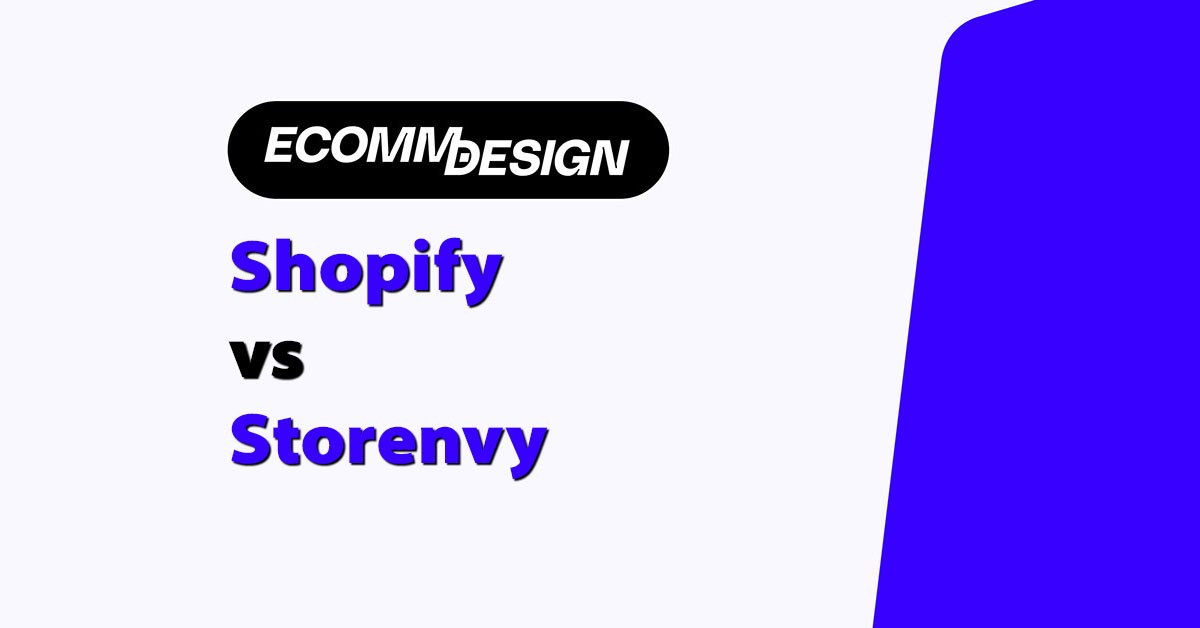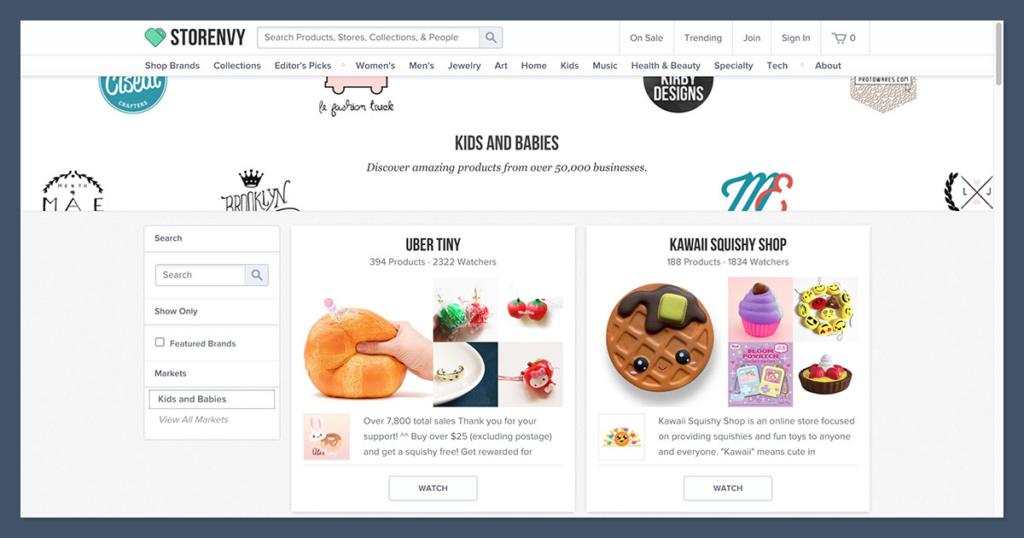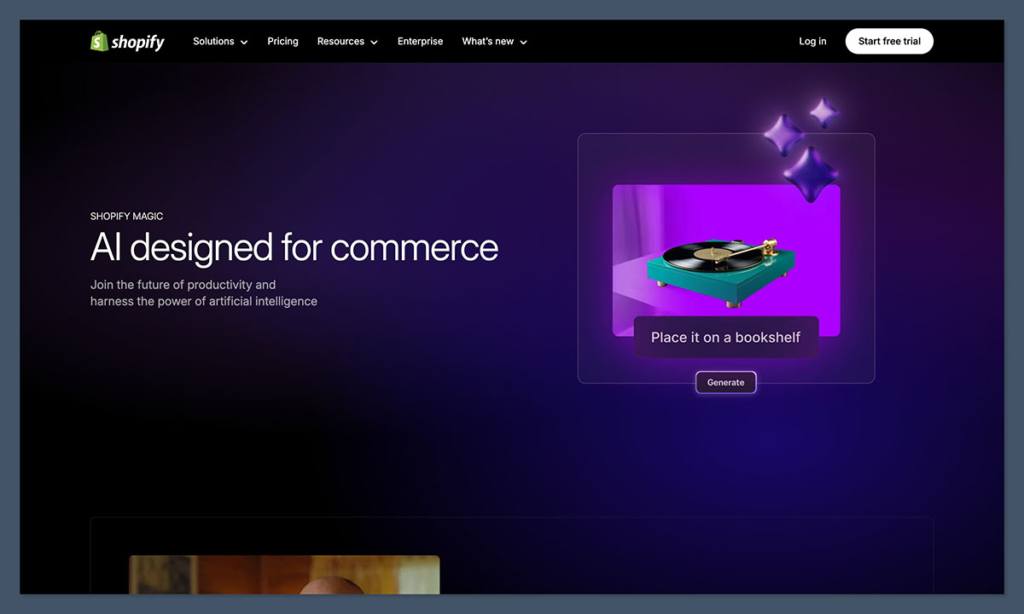
I consider Shopify to be one of the best ecommerce platforms available. It’s certainly one of the most scalable and flexible tools, thanks to its omnichannel selling capabilities, ease of use, and range of ever-evolving features.
Storenvy is a slightly more beginner-focused solution. It’s basically a “social marketplace” where people can sell products alongside competitors, but there are limited options to build a memorable brand with this platform.
I put both solutions to the test to bring you this comprehensive comparison guide.
Quick Verdict, Pros and Cons
In my tests, Shopify outperformed Storenvy in virtually every category, offering more flexible themes, extensive ecommerce features, and even unique AI-powered capabilities.
The biggest benefit of Storenvy is that it offers instant access to an audience of potential buyers, but the overall functionality is extremely limited, and there are better marketplaces to choose from in my opinion.
Storenvy Pros and Cons

Pros:
- Instant access to customers through a thriving marketplace
- Cost-effective for smaller companies
- Great social platform for connecting with buyers
- No technical knowledge required
- Some options to customize your storefront
Cons:
- Fees can be quite high for extra features
- Handling and commission fees on some plans
- Limited features compared to Shopify
Shopify Pros and Cons

Pros:
- Excellent range of themes and design tools
- Great AI functionality
- Lots of ecommerce features
- Omnichannel selling capabilities
- Thousands of integrations for scalability
- Easy to use for beginners
Cons:
- Extensive customization can be complex
- Transaction fees for companies not using Shopify Payments
Storenvy vs Shopify: The Core Features
While both Shopify and Storenvy are ecommerce tools, they work in very different ways.
Shopify is an omnichannel commerce platform and website builder.
Storenvy is a marketplace, but it does allow you to create a custom storefront, and use your own web domain (on some plans).
Website Design: Themes and Editors
Compared to Shopify, Storenvy takes a very different approach to web design. Notably, I do like the fact that you get more customization options for your storefront than you would with a marketplace like Amazon or Etsy.
You can adjust the design of your store, and even dive into HTML and CSS to make your website look unique.
However, there are limits to how much you can change.
Mostly, you’ll be able to adjust colors, text, banners, and background images. You can also add your own custom domain, which is a nice touch, but most Storenvy stores look very similar.

Shopify gives you a lot more freedom to build an entirely bespoke ecommerce store. You get hundreds of unique themes to choose from (free and premium).
You can dive into code if you have the technical knowledge, or make simpler changes with the intuitive website editor.
You can also add your own domain, and experiment with the copy on your website using Shopify’s AI tools.
The great thing about Shopify’s themes is they also come with extra features to experiment with, such as countdown timers, age verification pages, mega menus, and more.
Ecommerce Capabilities and Business Management
Both Storenvy and Shopify allow companies to sell online, but once again, Shopify is a far more robust platform.
With Storenvy you list your products on a storefront, and they can appear alongside various other items on a thriving social marketplace too.
I do like the “community-focused” nature of Storenvy, which allows customers to follow or “Envy” your products, which boosts their visibility.
Shoppers who watch your store are also notified when you add a new product, and the more activity your storefront gets, the more “featured” your products are.
However it does take a lot of work to earn promotions.
The management tools are pretty basic, but you do get order fulfillment and inventory management options.
Shopify, on the other hand, gives you a comprehensive omnichannel platform where you can sell everything from physical products, to digital items and courses (with add-on integrations).
There’s an integrated payment processor, or you can choose to add one of your own, plus you get a world-class checkout experience.
There are also no limitations on how many products you can sell, whereas Storenvy restricts your products based on your plan.
With Shopify, you can also sell on social media and marketplaces (alongside your own store), plus you get comprehensive staff, order, and inventory management tools, as well as shipping and fulfillment solutions, and the ability to integrate with POD and dropshipping apps.
Marketing Capabilities and Artificial Intelligence
From a marketing perspective, Storenvy does have some useful features.
Aside from “featuring” sellers with a lot of followers and allowing you to communicate with your target audience through chat, you can also create emails to engage your customers, and create promotional codes, vouchers, and discount options for your customers.
The biggest downside is that your promotional opportunities are limited based on your plan. For instance, on the cheapest plan (not the free plan), you can only share up to 25 discounts.
There aren’t many tools for search engine optimization either – you can’t even create your own blog.
Shopify also allows business owners to create voucher codes and discounts, as well as promotional banners, bundles to increase average order values, and more.
You can access SEO features like the ability to create site maps and adjust your meta descriptions and title tags.
Also, all plans come with a built in blog, as well as tools for email marketing, and the ability to chat with your customers through Shopify Inbox.
Shopify also definitely stands out for its AI features – I couldn’t find any intelligent capabilities on Storenvy. However, with Shopify, you get Shopify Sidekick to help you build and optimize your store, as well as Shopify Magic.

Shopify Magic can help companies create content for website product pages and ads in seconds, plus you can alter product backgrounds, generate FAQs, elevate your email campaigns with AI, and even sell to customers through chat with artificial intelligence.
Ease of Use and Integrations
Although some people feel Shopify has a slight learning curve – particularly if you want to dive into the code within your store, I think it’s extremely user-friendly.
You get some excellent website editing tools that require no coding knowledge, and there are plenty of tool tips to guide you when you’re editing things on your dashboard.
Storenvy is very easy to use too, giving you the ability to create a store with no design or coding knowledge – although you can use CSS and HTML if you choose. There’s also a great central dashboard where you can track your orders and manage your store.
From a scalability perspective, Shopify definitely wins. Aside from integrating with other sales channels to give you more selling opportunities, the platform also comes with a huge marketplace where you can find thousands of apps for marketing, order fulfillment, analytics, and more.

Storenvy does support some integrations, and apps, but there aren’t as many options to choose from – your best option is usually to access Zapier and set up your own webhooks, which can be a bit more complicated for beginners in my opinion.
Customer Support, and Analytics
One thing that confused me about Storenvy is that it lacks any significant built-in analytical tools. You can track top referring URLs, search engine terms, and sales counts, but that’s about it.
You’ll need to integrate your store with Google Analytics for more in-depth insights.
Shopify, on the other hand, offers a comprehensive dashboard where you can view information on sales figures, top-performing products, returning customers, and more.
You can also create custom reports tailored to your needs, track tax information, and build financial reports.
Storenvy is lacking from a customer support perspective too. The number of self-help resources on the platform is extremely limited.
Additionally, although email is available for contacting the team directly, you can’t use live chat or phone calls, and it can take more than a day to get an answer to any questions you might have.
Shopify offers 24/7 email, live chat, and phone support on all of their plans, and serves customers in multiple languages too.
Plus, Shopify has a huge online community, as well as lots of great self-help resources, such as FAQs, guides, courses, videos, blogs, and tutorials.
Storenvy vs Shopify: Fees and Pricing
Storenvy certainly seems like the cheaper option for beginners in the online sales landscape. There’s a free plan (which you won’t get with Shopify), but it’s pretty restrictive, only allowing you to sell up to 20 products.
The paid plans start at $9.99 per month for up to 100 products, $24.99 per month for 500 products, and $49.99 per month for 5,000 products.
If you want to avoid handling fees and commissions (which also drain your income), you’ll need the $49.99 per month plan.
This is also the only plan that gives you unlimited discounts to share with customers, and all of the features offered by Storenvy.
Shopify’s cheapest plan is the Starter plan for $5 per month, though it doesn’t allow you to build an online store – instead you can simply sell through social media and messaging apps with a link.

The core plans start at $39 per month for Basic Shopify, $105 for Shopify, and $399 per month for Advanced Shopify. Plus, there’s an enterprise plan (Shopify Plus), starting at $2,300 per month depending on your specific needs.

Notably, Shopify can charge transaction fees, but you can avoid these by using the integrated payment processer (Shopify Payments).
Storenvy vs Shopify: The Verdict
Ultimately, Storenvy has some great feature for beginners in the ecommerce space, allowing them to sell through a thriving marketplace and experiment with their own storefront.
However, I think Shopify is the better option overall. Not only is it more feature-rich and intuitive than Storenvy, but it’s far more scalable too.
Although you might need to spend a little extra to get started with Shopify, you’ll also have more potential to grow your store, and make a significant amount of revenue.



